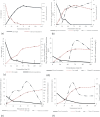Exploring the potential of soapstock over a glycerol in vitamin K2 production by Bacillus subtilis natto: a comparative analysis
- PMID: 39731131
- PMCID: PMC11681655
- DOI: 10.1186/s12934-024-02629-1
Exploring the potential of soapstock over a glycerol in vitamin K2 production by Bacillus subtilis natto: a comparative analysis
Abstract
Background: Vitamin K2 is an essential nutrient for blood coagulation and cardiovascular health and mainly produced by bacteria strain like B. subtilis. researchers have explored producing strain improvement, cultivation mode, environmental optimization, increased secretion, and using cheaper carbon and nitrogen sources in order to increase vitamin K2 productivity. This study examines the impact of varioius concentration of soapstock, which is a by-product of vegetable oil refining, as an alternative carbon source with lower pirce, in the fermentation medium instead of glycerol on the microbial synthesis of vitamin K2 using B. subtilis natto ATCC 23857.
Results: The results demonstrate that when the glycerol in fermentation medium was substituted with soapstock, by 75% concentartion, the fermentation process produced a yield of 158.16 mg/L of vitamin K2 after 72 h; This was 3.8 times more than the control medium containing glycerol. When the entire culture medium was replaced with wastewater, the vitamin K2 concentration reached 21.18 mg/L, 52% of the control medium's concentration. If the carbon sources in the fermentation medium consisted of 20% soapstock and 47.4 g/L glycerol (maintaining the same final glycerol concentration as the control medium), the vitamin K2 concentration reached 35.7 mg/L or 85.8% of the control medium. The analysis of soapstock fermentation medium characteristics reveals that after fermentation with B. subtilis, the COD of soapstock fermentation medium was dramatically reduced from 259,500 mg/L to 57,830 mg/L.
Conclusions: Using soapstock as an alternative carbon source for fermentation did not negatively impact the bioprocess and increased vitamin K2 production. Therefore, this research introduces an alternative carbon resource for vitamin K2 production and paves the way for the biorefinement of soapstock.
Keywords: Bacillus subtilis natto; Carbon source; Crude glycerol; Soapsotck; Vitamin K2.
© 2024. The Author(s).
Conflict of interest statement
Declarations. Ethics approval and consent to participate: Ethics approval is not applicable as this article does not describe any studies involving human participants or animals. Consent for publication: Not applicable. Competing interests: The authors declare no competing interests.
Figures



Similar articles
-
Improvement of menaquinone-7 production by Bacillus subtilis natto in a novel residue-free medium by increasing the redox potential.Appl Microbiol Biotechnol. 2019 Sep;103(18):7519-7535. doi: 10.1007/s00253-019-10044-5. Epub 2019 Aug 5. Appl Microbiol Biotechnol. 2019. PMID: 31378837
-
Implementation of fed-batch strategies for vitamin K (menaquinone-7) production by Bacillus subtilis natto in biofilm reactors.Appl Microbiol Biotechnol. 2018 Nov;102(21):9147-9157. doi: 10.1007/s00253-018-9340-7. Epub 2018 Sep 14. Appl Microbiol Biotechnol. 2018. PMID: 30218375
-
Effects of medium components in a glycerol-based medium on vitamin K (menaquinone-7) production by Bacillus subtilis natto in biofilm reactors.Bioprocess Biosyst Eng. 2019 Feb;42(2):223-232. doi: 10.1007/s00449-018-2027-8. Epub 2018 Oct 27. Bioprocess Biosyst Eng. 2019. PMID: 30368608
-
[Prevention of osteoporosis by foods and dietary supplements. "Kinnotsubu honegenki": a fermented soybean (natto) with reinforced vitamin K2 (menaquinone-7)].Clin Calcium. 2006 Oct;16(10):1715-22. Clin Calcium. 2006. PMID: 17012826 Review. Japanese.
-
Microbial production of vitamin K2: current status and future prospects.Biotechnol Adv. 2020 Mar-Apr;39:107453. doi: 10.1016/j.biotechadv.2019.107453. Epub 2019 Oct 17. Biotechnol Adv. 2020. PMID: 31629792 Review.
Cited by
-
A High-Throughput Screening Strategy for Bacillus subtilis Producing Menaquinone-7 Based on Fluorescence-Activated Cell Sorting.Microorganisms. 2025 Feb 27;13(3):536. doi: 10.3390/microorganisms13030536. Microorganisms. 2025. PMID: 40142429 Free PMC article.
References
-
- Frandsen NE, Gordeladze JO. Vitamin K2 and bone health. In: Vitamin K2-vital for health and wellbeing. New York: IntechOpen; 2017. p. 101–23.
-
- Meganathan R. Biosynthesis of menaquinone (vitamin K2) and ubiquinone (coenzyme Q): a perspective on enzymatic mechanisms. In: Vitamins & hormones, vol. 61. New York: Academic Press; 2001. p. 173–218. - PubMed
-
- Capozzi A, Scambia G, Migliaccio S, Lello S. Role of vitamin K2 in bone metabolism: a point of view and a short reappraisal of the literature. Gynecol Endocrinol. 2020;36:285–8. - PubMed
Publication types
MeSH terms
Substances
LinkOut - more resources
Full Text Sources

